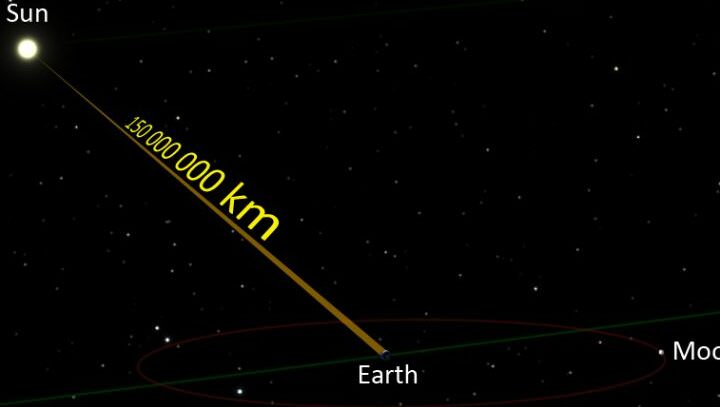A light-year is defined as the distance that light travels in one year. The International Astronomical Union has provided a definition of the light-year as the distance that light travels in a vacuum, unaffected by gravity, over the course of a Julian year, which is equivalent to 365 days. This is the accepted definition used in scientific literature.
In professional literature, the distance is often measured in parsecs or kilo- and megaparsecs.
There are specific measurements for the distance light travels in hours, minutes, days, and so on.
This is fascinating! It takes approximately 1.25 seconds for light to travel from the Earth to the Moon, and a little over 8 minutes for its beam to reach the Sun.
Fascinating fact about the nature of the cosmos
In the Orion constellation, the star Betelgeuse is poised to undergo a spectacular explosion in the near future.
Duration of an Earth year
An Earth year represents the distance covered by our planet in one year. When all factors are taken into consideration, it is determined that one light year is equivalent to 63,242 Earth years. This measurement specifically pertains to Earth, while other celestial bodies such as Mars or Jupiter have their own unique measurements. A light year measures the distance between two celestial objects. Despite both measurements representing distance, the values for light years and Earth years are significantly different.
Scale
Adjust the size of an object or image proportionally without altering its dimensions.
Resize an object or image while maintaining its aspect ratio.
Change the scale of an element without distorting its shape.
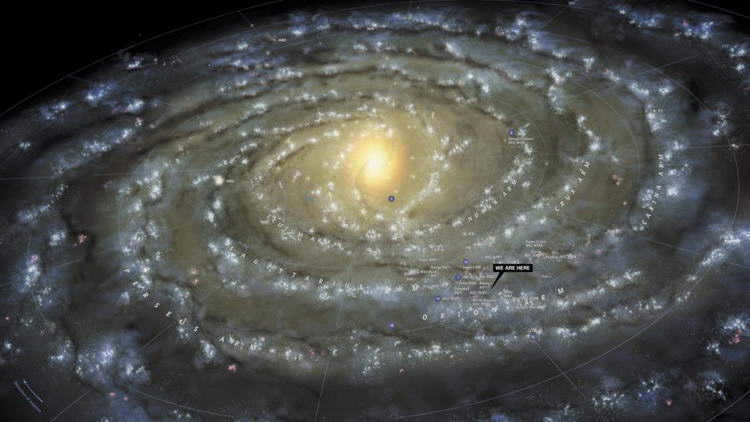
The Milky Way and Our Galaxy are one and the same.
Watch the Video
What is the definition of a light-year?
In the field of astronomy, similar to other scientific disciplines, there exists a specialized vocabulary that may appear peculiar and bewildering to those who are not familiar with it. What exactly does the term “elongation” signify? How about “perigee”? Are pulsars and quasars essentially the same phenomenon or are they distinct from each other? One of the frequently asked questions by individuals with an interest in astronomy is: what is the meaning of a light-year?
Let’s attempt to provide a simple answer.
A light-year represents a unit of measurement for distance
It is important to understand that a light-year is not a unit of time, but rather a unit of distance in the field of astronomy, similar to meters, kilometers, miles, or arshins in everyday life. To grasp this concept, let’s consider how distance can be measured without using a ruler or a surveyor’s compass.
As we are aware, the distancecovered by an object is equal to the object’s velocitymultiplied by the travel time (or s = v × t).
Imagine a scenario where you visit a store located precisely three kilometers away. Let’s assume you walk at a constant speed of 3 km/h. The question is, how long will it take you to reach the store? Naturally, it will take exactly one hour! Hence, we can conclude that the distance to the store is equal to 3 km, or we can express it as 1 “human hour”.
However, it is impractical to measure distances in “human hours” since everyone walks at different speeds. Moreover, even an individual’s walking speed varies depending on the circumstances. For instance, when someone is running late for a trolleybus, they might almost run, while in a park, they would leisurely stroll. Consequently, the time t required to cover the distance to the store will always differ.
But imagine a scenario where the velocity of a moving object remains constant at all times. It doesn’t matter where it’s headed, which direction it’s moving in, or the conditions under which measurements are taken. In this case, we can measure distance by simply considering the time it takes to travel, since the velocity (v) in the formula remains constant and the distance (s) depends solely on the time (t).
Hold on, you might ask, is there really an object that moves consistently – consistently! – at a constant speed?
The velocity of light
There exists such a phenomenon, and it is light! As we are aware, the velocitythe velocity of light in a vacuum remains constant at 299,792 kilometers and 458 meters per second. or, approximately, 300,000 kilometers per second.
Thus. a ray of light covers a distance of 300,000 kilometers within a single second! That’s quite impressive, isn’t it? If we manage to somehow measure the precise duration for which light travels the distance to an object, we will be able to determine the distance to it!
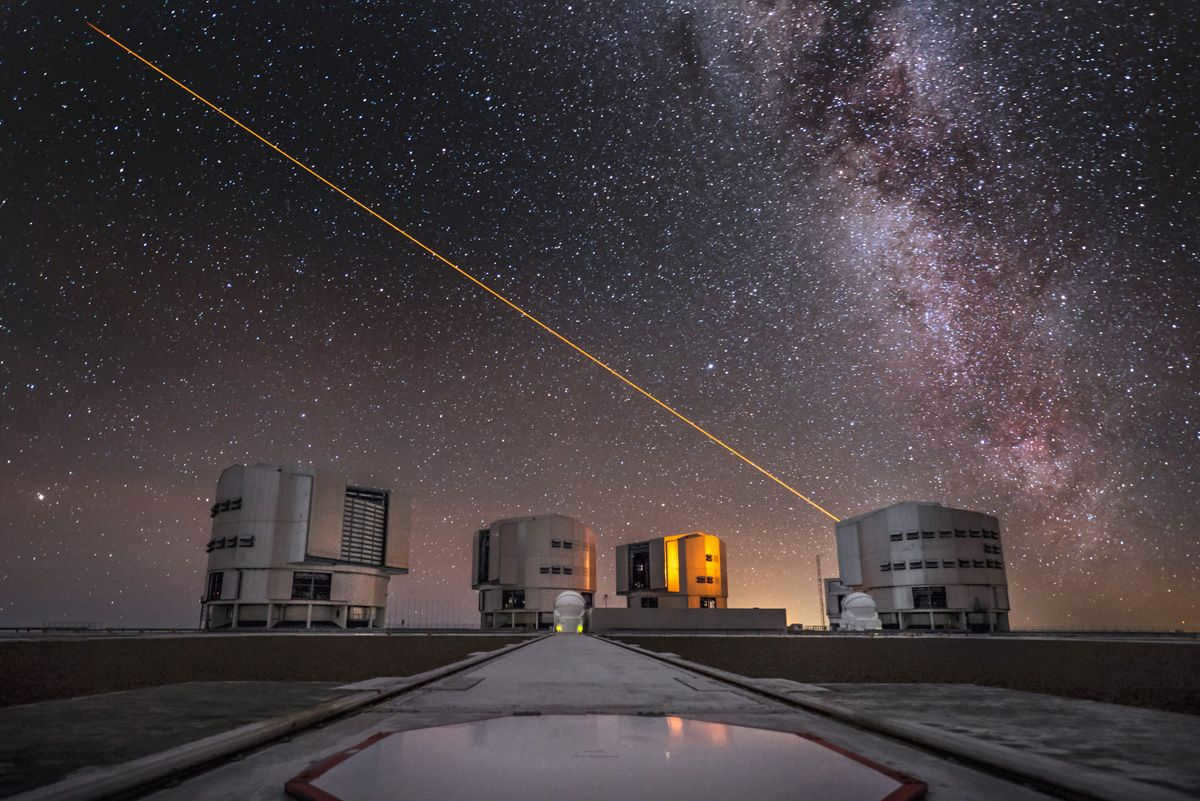
An artificial star is produced in the sky using a laser beam to evaluate the condition of the atmosphere. The velocity of light emitted from this beam remains constant! However, it is slightly reduced in the atmosphere compared to a vacuum. Image: ESO
In the 20th century, astronomers utilized a similar method to measure various distances within the solar system. For instance, they employed radar to assess Venus by transmitting a radio signal towards the planet and then recording its return. Radio waves travel at the speed of light, and scientists meticulously measured the time it took for the signal to come back. By utilizing the formula s = v × t, they were able to determine the distance between Earth and Venus with a high degree of accuracy. Presently, we have this measurement down to just a few meters.
Once again: why is it possible to measure distance using light? This is because the speed of light in a vacuum remains constant! (We should mention, in inertial reference frames.but let’s not complicate things too much.) Unlike the speed of people, cars, and rockets.
What exactly is a light-year?
Now let’s go back to the beginning. Let’s define it: A light-year is the distance that light (always moving– always! – at a constant speed of 300,000 kilometers per second.) travels in exactly one year!
Wow, that is an enormous number, isn’t it? If the speed of light is 300,000 kilometers per second, then it must be 60 times greater in a minute – a whopping 18 million kilometers. So in just one hour, light will have traveled an astounding 1 billion 80 million kilometers! (Now we have the answer to what a “light hour” is equal to! And in the process, we have also calculated the speed of light in kilometers per hour!)
1 light-year in kilometers
Now, let’s calculate the number of kilometers in a light year. To do this, we first need to determine the number of hours in a year. A day consists of 24 hours and a year consists of 365.25 days (with every fourth year being a leap year). Therefore, there are 24 × 365.25 = 8766 hours in a year. (Actually, it’s slightly less, 8760 hours. We are using a rough estimation for the number of days in a year.)
Now, to find out the equivalent of 1 light year in kilometers, we need to multiply the speed of light in km/h by the number of hours in a year. This calculation results in 9.461 billion kilometers. Therefore, 1 light-year is equal to 9.46 trillion kilometers!
That’s an astonishingly large number!
If the distance between the store and your home was this vast, and you were moving at the average speed of 3 km/h, it would take you 360 million years to walk there… Quite a long time, isn’t it?
Perhaps a rocket could be of assistance. Astronauts orbit the Earth at a speed of approximately 8 km/s or 28,800 km/h. However, even at this astonishing velocity, it would take them 37,500 years to reach the store.
What is the distance from the Sun to the Earth in light years?
Now, let’s tackle the inverse problem – let’s determine the distance from the Sun to the Earth in terms of light years. To do this, we divide the distance from the Sun to the Earth in kilometers by the length of a light year. The average distance from the Sun to the Earth (also known as an astronomical unit) is 150 million kilometers, while a light year is equivalent to 9.46 trillion kilometers. Dividing the former by the latter, we obtain 0.000016.
Therefore, the distance from the Sun to the Earth is 0.000016 light years. Alternatively… 8 light minutes.
What is the distance from the Earth to the Moon in light years?
The Moon is situated much closer to the Earth compared to the Sun, with an average distance of 384,000 kilometers or slightly more than one light second. So, how does this translate into light years? By dividing 384,000 km by the length of a light year in km (which remains at 9.46 trillion km), we arrive at the figure of 0.000000000041 light years. (Please feel free to double-check if you have any doubts.)
Clearly, using light years as a unit of measurement for the distance to the Moon is nonsensical. However, this leads to the question:
Why do we use light-years?
The reason is straightforward: to determine distances beyond the solar system!
Have you ever tried converting those distances into kilometers? No? Well, astronomers don’t want to either.
PS. What can I say, you can’t just hop in a car and drive through space…
What Does “Light Year” Mean?
When it comes to measuring the vast distances to the stars, regular units like kilometers just don’t cut it. Even the distance from Earth to the Sun, which is about 150 million kilometers on average, pales in comparison to the distances to other planets and stars. That’s why scientists use a special unit called a light year to measure these tremendous distances, and for even larger distances, they use a unit called a parsec.
There is often confusion between the Earth year and the light year. The Earth year is a unit of time, measuring the time it takes for the Earth to complete one revolution around the Sun, which is approximately 365 days. It has no relation to measuring distances.
A light-year, on the other hand, is a unit of distance measurement. It is equal to 9,460,730,472,580,800 meters, which is the distance that a ray of light travels in one Earth year.
The speed of light in a vacuum is constant and precisely known, making it an ideal tool for measuring vast distances. There are also other units of measurement:
These units represent the distance that light travels at a speed of approximately 300,000 km/s in a specific time period, such as a second or a minute.
As an illustration, the Moon is separated from Earth by a distance of 1.3 light seconds – this signifies the amount of time it requires for a ray of light to cover the gap between them. The gap between Earth and the Sun measures 8 minutes and 20 light seconds. The Voyager spacecraft, which has departed from the solar system, has journeyed a total of 14 light hours away.

What is the purpose of light-years?
If astronomers were to measure distances to other stars, nebulae, and galaxies in kilometers, these values would be incredibly large with an overwhelming number of zeros. While measuring distances within the solar system, where the values are in the “mere” millions and billions of kilometers, this approach would still be feasible. However, when it comes to interstellar distances, kilometers are too small of a unit. It’s comparable to using millimeters to measure the distances between cities.
A light-year is an enormous unit of measurement. However, when considering distances within our own galaxy, it becomes apparent just how vast these distances truly are. For instance, the nearest star to us is over 4 light-years away, while other stars can be hundreds or even thousands of light-years distant. Take the Orion Nebula, for instance, which is located 1,300 light-years away, or the center of our Galaxy, which is a staggering 26,000 light-years away. In terms of kilometers, the distance to the Orion Nebula would be a mind-boggling 12,651,000,000,000,000,000,000,000,000,000,000,000,000,000 kilometers. Clearly, light-years provide an incredibly convenient system of measurement for these interstellar distances.
However, it’s important to note that even these distances are relatively small when compared to the vastness of intergalactic distances. For instance, our neighboring galaxy, Andromeda, is located a staggering 2.5 million light-years away, and there are galaxies even further away, numbering in the billions.
However, we are limited to observing objects that are no more than 13.8 billion light years away. This is because the age of the universe is 13.8 billion years, so anything farther than that would be incredibly ancient.
A different unit of measurement: the parsec
While the light-year is a convenient way to measure cosmic distances, it is still relatively small. That’s why astronomers use another unit called the parsec.
1 parsec is equivalent to 3.26 light years, or approximately 30.8568 trillion kilometers.
The term “parsec” is derived from the words “parallax” and “second”. In practical terms, it represents the distance at which the radius of the Earth’s orbit, which is about 150 million kilometers, appears to be a segment of 1 arc second. Through simple calculations, astronomers have determined the length of a parsec.
However, the parsec itself is not a particularly large value. The distance to the closest star, Proxima Centauri, is 4.3 light-years, which is equivalent to just 1.3 parsecs. When dealing with even greater distances, kiloparsecs (kpc) and megaparsecs (mpc) are used, representing thousands and millions of parsecs respectively. For instance, the distance to the Andromeda galaxy is approximately 2.5 million light-years, or 0.77 Mpc. On an even larger scale, the observable Universe’s horizon is situated at a distance of 4 gigaparsecs (Gpc), which is equivalent to billions of parsecs.
What is a Light Year, How it is Measured, and its Use in Space Exploration
The concept of a light year is a unique unit of distance measurement used in space exploration. It is defined as the distance that light, traveling in a vacuum, covers within a period of 365 days. The vastness of the universe and the immense distances between celestial objects make it impractical to use our familiar metric system to measure such distances. Instead, scientists rely on the light year as a convenient and standardized unit of measurement.
The concept of a light-year represents the number of Earth years it takes for light to travel
An astronomical year refers to the duration of time it takes for the Earth to complete one revolution around the Sun.

A light-year is a unit of measurement used to quantify interplanetary distances. Consequently, it is impossible to measure one in terms of the other.
In a similar vein, it is possible to determine the volume of a nuclear explosion in liters. The explosive power of a blast is measured in TNT equivalent, while the volume is gauged in liters.
An astronomical year spans 365 days, and a light-year represents the distance that light travels in this timeframe.
How far is a light year in kilometers?
To better understand the concept, let’s take a look at a table that shows the distance of a light year and its various components.

*The estimation of the size of a light month is provided, as the length of earth months in the calendar varies.
Measuring Distance in Astronomy with Light Years
The light-year is a highly convenient unit of measurement for large distances in space and is widely used in the field of astronomy.

The speed of light represents the maximum rate of information propagation, enabling us to measure the time it takes for objects in the universe to interact by using light-years as a unit of distance.
The sunlight currently reaching our planet separated from the solar corona precisely 8 minutes and 20 seconds ago;
Additional instances can be found in Table #2, which provides the estimated distance between Earth and various celestial objects.
8.2 sv. min. This measurement is known as an “astronomical unit” and is roughly equal to 150 million kilometers.
Voyager 1 and Voyager 2.
Voyager 1 and Voyager 2 have journeyed for 19 and 17 sv hours, respectively. These spacecraft have ventured beyond our solar system and are currently exploring interstellar space.
Proxima of the Centauri constellation
The constellation Orion, specifically the star Betelgeuse, is a prominent feature in the night sky.
Located at the center of the Milky Way Galaxy, our home galaxy has a diameter of approximately 100,000 light-years.
The Andromeda Nebula galaxy is another fascinating celestial object.
At the edge of the observable Universe, we can catch a glimpse of the vastness of space.
The age of the observable Universe is estimated to be around 4.57∙10 10
light-years, meaning it would take about 45.7 billion years for the Sun’s rays to reach its edge!
If we imagine a state-of-the-art spacecraft launching from Earth and traveling at the third cosmic speed of 16.7 km/sec, it would take:
180,000 years to cover a distance of 1 light-year.
Approximately 78 millennia to reach Proxima Centauri.
To traverse the Milky Way galaxy from one edge to the other, it would take an astonishing 1 billion, 780 million years.
Our space traveler would need a staggering 36 billion years to reach the Andromeda Nebula. As a result, it is impossible for any of us living humans to venture to the newly discovered planetary systems where life could potentially exist due to their immense distance. The closest of these systems is situated 40 light-years away, meaning that a spacecraft traveling at the speed of light would still require a mind-boggling 600,000 years to reach it!
When contemplating these vast timeframes, it is important to bear in mind that the solar system came into existence a mere 4.57 billion years ago, planet Earth formed 4.54 billion years ago, and the universe itself is a relatively youthful 16 billion years old.
What is the distance in kilometers of a light year, and is it the same as the Earth’s light year?
Measuring the vastness of outer space in kilometers or miles is a challenging task. Scientists have considered alternative units of measurement for large distances. Light-years are frequently mentioned in science fiction movies and books, but not everyone understands their significance. Some individuals fail to distinguish them from ordinary terrestrial measurements.

The light-year is a widely used measure of cosmic distance. It is determined by taking into account the following factors:
One crucial requirement for this calculation is that the influence of any gravitational fields on light is negligible. This condition is met in a vacuum, where the speed of electromagnetic waves remains constant.
In the 17th century, scientists were conducting experiments to determine the velocity of light. Previously, astronomers had assumed that light rays traveled through space instantaneously. However, Galileo Galilei questioned this assumption and set out to calculate the time it took for a beam of light to travel a distance of eight kilometers. Unfortunately, his experiments were not successful. Another scientist, O. Rømer, also faced challenges in his research. He observed a time difference in eclipses of satellites orbiting other planets, which varied depending on the Earth’s position. When the Earth was farther from the other celestial object, it took longer for the light rays to reach the Earth’s surface. Despite his observations, Rømer was unable to calculate the exact speed of light.
Englishman James Bradley was the first to successfully estimate the speed of light in the XVIII century. He determined its value to be 301,000 km/s. In the following century, scientists utilized Maxwell’s theory of electromagnetism to precisely calculate the velocity of light. This research was conducted using advanced laser technologies, while also taking into consideration refraction coefficients. The calculated speed of light was found to be 299,792 kilometers and 458 meters per second. This discovery played a crucial role in establishing a convenient unit of measurement for outer space.
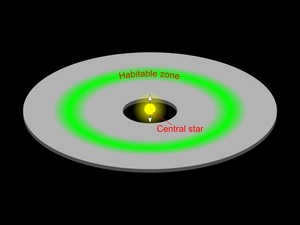
How many kilometers are equal to 1 light-year?
To calculate this, we start with the assumption that there are 365 days in a year. If we convert this into seconds, we get 86,400 seconds. And if we multiply this by the total number of days in a year, which is 31,557,600, we get the answer.
By calculating the distance traveled by a beam of light in one second and multiplying it by 31,557,600, we find that it is slightly over 9.4 trillion kilometers. This is the distance that is considered to be 1 light-year in terms of kilometers. It represents the distance that a beam of light would cover in 365 days, assuming it is traveling through a vacuum and is not affected by any gravitational fields.
Below are a few instances of distances computed using this method

Why is it significant?
Calculations in this particular unit of measurement are convenient within our universe. The use of hours, weeks, or months is less frequent. When measuring distances to faraway cosmic objects, the resulting number is immense. Using such values in mathematical calculations becomes challenging and impractical. Scientists have recognized this and have introduced another unit of measurement, the parsec, for astronomical calculations involving vast distances. The parsec is better suited for complex mathematical calculations. One light-year is equivalent to one-third of a parsec.
The Comparison of Light Years and Earth Years
In our daily lives, we often measure distance: to work, to the nearest store, or to another city. We compare different values to gain a better understanding of the differences. The concepts of light years and Earth years may seem similar to many, if not the same. People often have a desire to compare them. However, it is important to first define what is meant by an Earth year. An Earth year can be defined as the distance traveled by our planet in 365 days. Using these parameters, one light year is equivalent to 63,000 Earth years.
If an Earth year is measured in days, it is considered a unit of time, while a light year represents a measure of distance. Therefore, comparing these two values is meaningless, and there is no definitive answer to the question.
Video
Watch this video to gain a clear understanding of the concept of a light year.

https://t.me/space_c
A light year is the measurement of the distance that light travels within the span of one year. The International Astronomical Union has provided a definition for a light year – it is the distance that light travels through a vacuum, unaffected by gravity, over the course of a Julian year, which is equivalent to 365 days. This interpretation is commonly used in scientific literature. In terms of professional literature, distances are often calculated in parsecs or kilo and megaparsecs.
Prior to 1984, a light-year was determined by the distance that light could travel within a tropical year. The new definition differs from the previous one by a mere 0.002%. There is no significant distinction between the two definitions.
There are specific numerical values that correspond to the distances of light-hours, light-minutes, light-days, and so on.
Numerical values
- A light year corresponds to 9,460,800,000,000,000,000 kilometers,
- One month is equal to 788,333 million kilometers,
- A week is equivalent to 197,083 million kilometers,
- A day is approximately 26,277 million km,
- An hour is roughly 1,094 million kilometers,
- A minute is about 18 million kilometers,
- A second is approximately 300,000 kilometers.
Facts
It takes an average of 1.25 seconds for light to reach the Moon from Earth, but it takes a little over 8 minutes for light to reach the Sun.
These numbers are truly astonishing and have important implications for various calculations. After all, a light year is not the same as an Earth year.
The star Betelgeuse, located in the constellation Orion, is expected to explode in the near future, perhaps within a few centuries.
Betelgeuse is located 495 to 640 light-years away.
If it were to explode right now, the explosion wouldn’t be visible to Earth’s inhabitants for another 500 to 600 years.
So if you were to witness the explosion today, keep in mind that it actually happened around the time of Ivan the Terrible.
Earth year
The concept of an Earth year refers to the distance covered by the Earth in a span of one year. When considering all the relevant calculations, it is estimated that one light year is equivalent to 63,242 Earth years. It is important to note that this figure specifically pertains to the Earth, and for other celestial bodies like Mars or Jupiter, the values would vary significantly. A light year is a unit of measurement used to calculate the distance between two celestial objects. Despite both Earth years and light years being measures of distance, their numerical values differ greatly.
Imagine a futuristic spacecraft embarking on a journey beyond the boundaries of our Solar System, propelled by the incredible speed of the cosmos, approximately 16.7 km/s. The spacecraft’s first milestone would be to traverse a single light-year, an astonishing feat that would require a staggering 18,000 years!
However, the real challenge lies ahead as our spacecraft sets its sights on the Alpha Centauri star system, located 4.36 light years away. The arduous journey to reach this neighboring star system would demand an incredible amount of patience, spanning an estimated 78,000 years!
But the vastness of our own Milky Way galaxy truly puts the enormity of this voyage into perspective. Spanning approximately 100,000 light years, the spacecraft would need an astonishing 1 billion, 780 million years to successfully traverse its immense expanse. Yes, you read that correctly – 1 billion, 780 million years!
And if our intrepid spacecraft were to venture even further into the cosmos, aiming for the Andromeda Nebula, the nearest large galaxy to us, it would find itself faced with an astronomical challenge. After an astonishing 36 billion years of travel, the spacecraft would finally reach its destination.
It’s mind-boggling to think that even though the Universe is believed to have originated a mere 16 billion years ago, our spacecraft’s journey would still pale in comparison to its age. The vastness of space truly puts our own existence into perspective.
The vast distances between stars make it impossible to measure them in conventional units like kilometers or miles. Instead, astronomers use a unique system of measurement. For example, they estimate that the minimum distance from Earth to Mars is 55.76 million kilometers. However, when it comes to measuring distances between stars, things get more complicated. Astronomers typically use units like light-years and parsecs.
An astronomical unit is a unit of measurement used for objects in the Solar System and nearby objects in the Universe. It is defined as the average distance between the Earth and the Sun, which is approximately 149,598,100 kilometers (with a margin of error of about 750 kilometers). Interestingly, modern observations have shown a gradual increase in this value, about 15 centimeters per year. This increase is believed to be caused by factors such as the Sun losing mass and the effects of the solar wind.

A light-year is the distance that light travels in a single year, which is equivalent to 9,460,730,472,580,800 meters. Interestingly, the light we see from the stars on a clear night has actually traveled for many centuries to reach our planet, and some of those stars may not even exist anymore.
A parsec, also known as the “parallax of an angular second,” is a unit of distance that is defined as the distance from which the average radius of the Earth’s orbit (measured perpendicular to the line of sight) is seen at an angle of one arc second. In simpler terms, a parsec is equal to 3.26 light-years.
It’s worth noting that while the concept of a light-year is commonly used in popular science and fantasy literature, parsecs are more commonly used in professional writings and research.
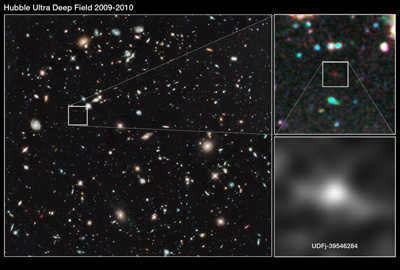
(The galaxy UDFj-39546284, located 13.3 billion light-years away from Earth, appears as a red dot in the image captured by the Hubble telescope)
Alpha Centauri is the closest star to us, situated at a distance of 4.37 light-years from Earth. However, the farthest galaxy observed (as of December 2012) is an astonishing 13.3 billion light-years away! This means that if the sun in this particular galaxy (known as UDFj-39546284) were to go out, it would take a very long time for mankind to become aware of it.
Galactic distance scales
A light-year (abbreviated as sv. yr. or ly) is a unit of length used to measure astronomical distances, representing the distance that light travels in one year.
More precisely, as per the International Astronomical Union (IAU), a light year is defined as the distance traveled by light in a vacuum, without any influence from gravitational fields, over the span of one Julian year (which is defined as 365.25 standard days or 31,557,600 seconds). This particular definition is recommended for use in popular scientific literature. In professional literature, parsecs and their multiples (such as kiloparsecs and megaparsecs) are often employed to represent large distances instead of light years.
Prior to 1984, a light-year was defined as the distance covered by light in one tropical year, specifically during the epoch 1900.0. The new definition deviates from the old one by approximately 0.002%. Since this unit of measurement is not utilized for highly precise calculations, there is no practical distinction between the old and new definitions.
- Approximately 9.46 petameters (9,460,730,472,580,800 meters)
- 63,241.077 astronomical units (a.e.)
- 0.306,601 parsecs
Related units
The following units are not commonly used, usually only in popular publications:
- 1 light second = 299,792.458 km (exact)
- 1 light minute is approximately 18 million km
- 1 light hour is approximately 1079 million km
- 1 light day is approximately 26 billion km
- 1 light week is approximately 181 billion km
- 1 light month is approximately 790 billion km
Measuring Distance with Light-years
The light-year serves as a useful tool for expressing astronomical distances in a qualitative manner.
| Seconds | 4.710 × 10-8 | The average distance to approximately 380,000 km. This means that a ray of light emitted from the surface would take about 1.3 seconds to reach the surface of the Moon. |
| Minutes | 1.6 × 10-5 | One astronomical unit equals approximately 150 million kilometers. Thus, it takes about 500 seconds (8 minutes and 20 seconds) for light to reach the Earth. |
| Hours | 0.0006 | The average distance from the Sun to approximately 5 light hours. |
| 0.0016 | The Pioneer and , flying beyond , have traveled about one hundred astronomical units from the Sun in the approximately 30 years since launch, and their response time to requests from Earth is approximately14 hours. | |
| Year | 1.6 | The inner edge of the hypothetical is located 50,000 a. e. from the Sun, and the outer edge is 100,000 a. e. It would take light about a year and a half to travel the distance from the Sun to the outer edge of the cloud. |
| 2.0 | The maximum radius of the region of the Sun’s gravitational influence (the “Hill Sphere”) is about 125,000 a. e. f. | |
| 4.2 | The closest one to us (not counting the Sun), Proxima Centauri, is 4.2 sv. years away. | |
| Millennia | 26,000 | The center of our Galaxy is approximately 26,000 light years from the Sun. |
| 100,000 | The diameter of our disk is 100,000 light years. | |
| Millions of years | 2.5 × 106 | The closest galaxy to us, the famous M31, is 2.5 million light-years away. |
| 3.14 × 106 | (M33) is located 3.14 million light-years away and is the most distant stationary object visible to the naked eye. | |
| 5.8 × 107 | The nearest, the Virgo cluster, is 58 million light-years away. | |
| Tens of millions of light years | The characteristic size of galaxy clusters in diameter. | |
| 1.5 × 108 – 2.5 × 108 | The gravitational anomaly “Great Attractor” is located at a distance of 150-250 million light years from us. | |
| Billions of years | 1.2 × 109 | The Great Wall of Sloan is one of the largest formations in the world, its size is about 350 Mpc. It would take about a billion years for light to travel from end to end. |
| 1.4 × 1010 | The size of the causal region of the Universe. It is calculated from the age of the Universe and the maximum speed of information transmission – the speed of light. | |
| 4.57 × 1010 | The associated distance from the Earth to the edge of the observable Universe in any direction; the associated radius of the observable Universe (within the standard Lambda-CDM cosmological model). |
The measurement of cosmic distances is not easily done in conventional meters and kilometers, thus astronomers employ alternative units in their research. One such unit is known as the light-year.
Numerous enthusiasts of science fiction are acquainted with this notion, as it is frequently encountered in movies and literature. Nevertheless, not all individuals are aware of the precise value of a light-year, and a few even mistakenly believe it to be akin to the standard annual time calculation.
Contrary to popular belief, the light year is not a measurement of time, but rather a unit of length commonly employed in the field of astronomy. Specifically, it refers to the distance that light travels within the span of one year.
Typically found in astronomy textbooks and frequently utilized in works of science fiction, the light year serves as a means to define distances within our solar system. However, when more precise mathematical calculations or measurements of interstellar distances are required, an alternative unit of measurement comes into play – .

The emergence of the light-year in the field of astronomy was a result of the advancements made in stellar sciences and the necessity to utilize parameters that could effectively measure the vastness of space. This concept came into existence a few years after the successful measurement of the distance between the Sun and the star 61 Swan in 1838.
In its initial stages, the light-year was defined as the distance that light could travel within a tropical year, which refers to the complete cycle of seasonal changes. However, since 1984, the Julian year (365.25 days) has been adopted as the standard, leading to more precise measurements.
What is the method for measuring the speed of light?
In order to determine the light year, scientists needed to establish the speed of light. At one time, astronomers believed that light traveled instantaneously through space, but in the 17th century, this assumption began to be questioned.
The first attempts at calculating the speed were made by Galileo Gallilei, who set out to measure the time it took for light to travel a distance of 8 km. Unfortunately, his experiments were not successful. It wasn’t until 1728 that James Bradley was able to approximate the speed, determining it to be around 301,000 kilometers per second.
How fast does light travel?
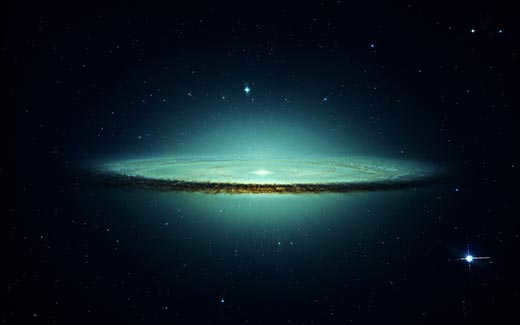
Despite Bradley’s accurate calculations, the exact speed of light could only be determined in the 20th century through the use of modern laser technology. The advanced equipment allowed for calculations to be made with adjustments for the refractive index of light rays, resulting in a value of 299,792,458 kilometers per second. These precise figures continue to be used by astronomers today. Additionally, these calculations have helped establish the time it takes for light to travel around the Earth without being affected by gravitational fields.
While the speed of light is not comparable to the distances on Earth, it is still used in calculations because people are accustomed to thinking in terms of “terrestrial” measurements.
What does the term “light year” mean?
The concept of a light year can be understood by considering the distance light travels in a certain amount of time. Specifically, one light second is equal to 299,792,458 meters, which means that light covers a distance of 17,987,547,480 meters in just one minute. This measurement is often used by astrophysicists to determine distances within planetary systems.
When it comes to studying celestial bodies on a cosmic scale, it is more practical to use the unit of measurement known as a light year. A light year is equivalent to 9.460 trillion kilometers or 0.306 parsecs. By observing cosmic objects, humans are able to witness the past, as the light emitted from these objects takes many years to reach Earth.
Illustrations of Light-Year Distances
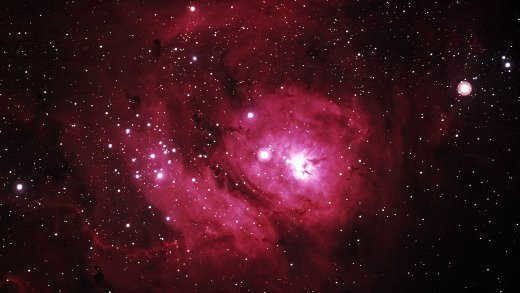
Thanks to the ability to calculate the velocity of light beams, astronomers have been able to determine the distance to many celestial bodies in terms of light-years. As a result, the distance from our planet to the Moon is equivalent to 1.3 light seconds, to Proxima Centauri – it is 4.2 light years, and to the Andromeda Nebula – it is 2.5 million light years.
The distance that light beams travel between the Sun and the center of our galaxy is approximately 26 thousand light years, while the distance between the Sun and the planet Pluto is about 5 light hours.
On February 22, 2017, NASA announced the discovery of 7 exoplanets near the solitary star TRAPPIST-1. Three of these planets are situated within the habitable zone, where liquid water can exist, and water is a crucial element for supporting life. It is also noted that this star system is situated 40 light years away from Earth.
This news caused quite a stir in the media, with some even speculating that humanity is on the verge of establishing new settlements on this new star. However, this is not true. The distance of 40 light years is incredibly vast, encompassing an unfathomable number of kilometers.
The concept of the third space velocity is familiar from physics courses – it refers to the speed that an object near the Earth’s surface must achieve in order to venture beyond our solar system. This velocity is measured at 16.65 km/sec. Traditional orbital spacecrafts are launched at a speed of 7.9 km/sec, allowing them to orbit the Earth. In theory, a speed of 16-20 km/sec is within the realm of possibility for modern Earth technologies, but nothing more!
As of now, mankind has not yet discovered a way to propel spaceships at speeds faster than 20 km/sec.
Let’s calculate the amount of time it would take for a starship traveling at a speed of 20 km/sec to cover a distance of 40 light-years and reach the star TRAPPIST-1.
One light-year is the distance that a beam of light travels in a vacuum, with the speed of light being approximately 300,000 kilometers per second.
A spaceship created by humans travels at a speed of 20 km/sec, which is 15,000 times slower than the speed of light. It would take such a ship 600,000 years to cover a distance of 40 light-years!
An Earth ship (with current technological capabilities) would take around 600,000 years to reach the star TRAPPIST-1! According to scientists, the existence of intelligent human beings on Earth is estimated to be only 35-40 thousand years, so 600,000 years is quite a long time!
In the foreseeable future, advancements in technology will not enable mankind to reach the TRAPPIST-1 star system. Despite the potential of promising propulsion systems such as ion, photon, and space sails, which currently only exist in the realm of imagination, estimates suggest that they could propel a spacecraft to a velocity of 10,000 km/s, thereby reducing the travel time to the TRAPPIST-1 system to 120 years. While this timeframe may be somewhat acceptable for hibernation-based space travel or for multiple generations of settlers, it is important to note that these propulsion systems are still purely fantastical in nature.
Even the closest stars to our own are still incredibly distant and beyond the reach of human exploration, not to mention the stars within our own Milky Way galaxy or other galaxies entirely.
As you can observe, out of all the individuals currently living, no one will ever step foot on the surface of a planet located in another star system.
Undoubtedly, when you encounter this statement in a science fiction action movie, such as “Tatooine is twenty light years away from us,” many people have legitimate queries. I will address some of them:
So, what exactly is a light-year ?
How much time does it take for a spaceship to travel one light-year from Earth ?
I have decided to dedicate today’s article to elucidating the significance of this unit of measurement, comparing it to our conventional kilometers, and illustrating the vastness of the Universe.
Imagine a person who, against all regulations, is driving on a highway at a speed of 250 km/h. In just two hours, he will have covered a distance of 500 kilometers, and in four hours, he will have covered a whopping 1000 kilometers. Of course, this is assuming he doesn’t crash along the way…
You might think that’s fast! However, if our daredevil racer were to go around the world (approximately 40,000 km), he would need 40 times more time. That’s 4 x 40 = 160 hours. That’s almost an entire week of non-stop riding!
In the end, though, we wouldn’t say he traveled 40,000,000 meters. This is because our laziness has always driven us to come up with and use shorter alternative units of measurement.
Everybody should be aware from their high school physics class that the fastest traveler in the entire universe – is light. In just one second, its beam covers a distance of roughly 300,000 kilometers, meaning it could go around the Earth in just 0.134 seconds. That’s a whopping 4,298,507 times faster than our virtual racer!
When it comes to traveling from our planet to the moon, light takes about 1.25 seconds on average to make the journey. However, when traveling from Earth to the Sun, it takes a little over eight minutes to reach our stellar neighbor.
Isn’t that mind-blowing? Despite this, there is still no concrete evidence of speeds greater than that of light. Therefore, the scientific community has decided that it would be logical to measure cosmic distances using units based on the intervals it takes for radio waves to pass (which includes light as well, of course).
Thus, a light-year is simply the distance that a beam of light travels in the span of one year. On the scale of interstellar distances, it doesn’t make much sense to use units of measurement smaller than this. However, there are some smaller units that can be used. Here are their approximate values:
– 1 light second ≈ 300,000 kilometers;
– 1 light minute ≈ 18,000,000 km;
– 1 light hour ≈ 1,080,000,000,000 km;
– 1 light day ≈ 26,000,000,000,000,000 km;
– 1 light week ≈ 181,000,000,000,000 km;
– 1 light month ≈ 790,000,000,000,000,000 km.
And now, to give you a sense of the magnitude of these numbers, let’s calculate the equivalent of one light year.
There are 365 days in a year, 24 hours in a day, 60 minutes in an hour, and 60 seconds in a minute. Therefore, a year consists of 365 x 24 x 60 x 60 x 60 = 31,536,000 seconds. In a single second, light travels a distance of 300,000 kilometers. Thus, in one year, the ray of light will cover a distance of 31,536,000 x 300,000 = 9,460,800,000,000,000 km.
This figure can be pronounced as: TWENTY TRILLION, FOUR HUNDRED SIXTY SIXTY MILLIARDS AND EIGHTY MILLION kilometers.
Naturally, the exact value of a light-year slightly differs from our calculation. However, when describing distances to stars in popular science articles, extreme precision is not necessary, and a discrepancy of a hundred or two million kilometers will not have a significant impact.
Now, let’s proceed with our thought experiments…
Our nearest star system, Alpha Centauri, is located 4.36 light-years away (see the image at the beginning). If a spaceship were to travel to Alpha Centauri, it would take approximately 78,000 years!
The Milky Way galaxy is approximately 100,000 light-years across. If a spaceship were to travel across the entire galaxy, it would take 1 billion, 780 million years.
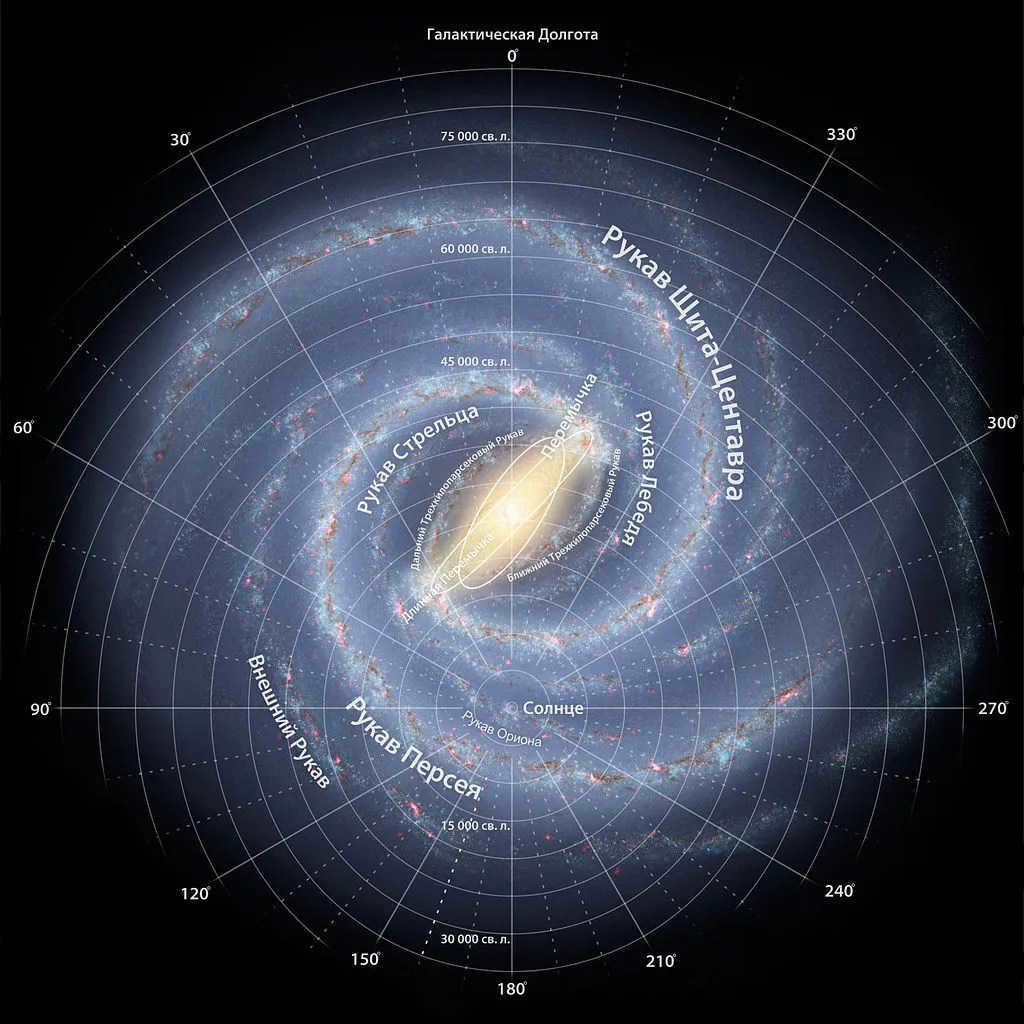
The nearest large galaxy, the spacecraft will take 36 billion years to reach it.
That’s the pie. And even in theory, the universe only started 16 billion years ago.
The cosmic scale can begin to be marvelled at even beyond the solar system because it is very large in itself. The creators of the project, for example, have demonstrated this very well and clearly. If the Moon were only one pixel: http://joshworth.com/dev/pixelspace/pixelspace_solarsystem.html .
This is probably the end of today’s article. All your questions, comments, and wishes are welcome in the comments below it.
Did you enjoy it?
If you found the article interesting, please click on the button. Your support will contribute to the development of the project. Thank you!
Light-year is a unit of measurement used in astronomy to determine distances outside our solar system. It represents the distance that light can travel in one year. Specifically, it is the distance that light can travel in a vacuum, unaffected by gravitational fields, over the course of one Julian year, which is equivalent to 365.25 days or 31,557,600 standard seconds. In Russian literature, the light-year is referred to as “sv. g.”, while in foreign literature, it is denoted as “ly”.
Here are the equivalent measurements for one light-year:
Light-year in kilometers: 9,460,730,472,580.8 km.
9,460,730,472,580,800 meters.
63,241.077 astronomical units (a.e.).
1 light-year is equal to 0.306,601 parsecs.
In addition to the light year, there are also smaller units of distance: the light month, the light week, the light hour, the light minute, and the light second. While these units are not commonly used, it is interesting to consider how various distances can be expressed in them.
The light-year is a convenient unit of measurement in astronomy, as it reflects the maximum speed at which information can travel in our universe: the speed of light. By expressing distances in light-years, we can understand how quickly one celestial object can impact another.
As an instance, you might have been informed that the star Betelgeuse in the Orion constellation is predicted to undergo a detonation in the near future (in reality, within a few centuries).
Betelgeuse is situated at a distance of 495 to 640 light years from us.
If it were to explode at this very moment, the explosion would only be observable by the inhabitants of Earth in 500-600 years.
And if you happen to witness the explosion today, bear in mind that the actual event occurred around the time of Ivan the Terrible.
From this particular illustration, it becomes evident how advantageous the concept of a light year is – it simultaneously conveys both distance and time.
How many Earth years are in a light year? It’s a rather peculiar query, but one that occasionally arises. A light year represents a measurement of distance, as stated above, while an Earth year measures time. Hence, the answer to the question of how many Earth years are equivalent to one light year is – none:-)
A light year is defined as the distance that light travels in the span of a year. The International Astronomical Union has provided its definition that a light year is the distance light travels in a vacuum, unaffected by gravity, over the course of a Julian year. A Julian year consists of 365 days. This interpretation is employed in scientific literature.
When it comes to professional literature, distances are typically calculated in parsecs or kilo- and megaparsecs.
There are specific measurements that determine the distance of light in various units of time.
- A light year is equivalent to 9,460,800,000,000,000 kilometers,
- A month measures approximately 788,333 million kilometers
- A week spans about 197,083 million kilometers,
- A day covers 26,277 million km,
- An hour consists of 1,094 million kilometers,
- A minute corresponds to roughly 18 million kilometers,
- A second measures approximately 300,000 kilometers.
That’s fascinating! It takes an average of 1.25 seconds for light to reach the Moon from Earth, and a little over 8 minutes for light to reach the Sun.
The star Betelgeuse, located in the Orion constellation, is expected to explode in the near future.
Betelgeuse is situated at a distance of approximately 495 to 640 light years from our planet.
If it were to undergo a cataclysmic explosion at this very moment, the event would not be observable to Earth’s inhabitants until approximately 500 to 600 years from now.
Furthermore, it is worth noting that if one were to witness the explosion in the present day, it is important to keep in mind that the actual occurrence of the explosion would have transpired during the reign of Ivan the Terrible…..
Earth year
An Earth year corresponds to the distance covered by the planet Earth in a period of one year. When considering all the calculations, it can be determined that one light year is equivalent to 63242 Earth years. However, it is important to note that this value specifically applies to the Earth, and for other celestial bodies such as Mars or Jupiter, the figures will be significantly different. A light year measures the distance between two celestial objects. Despite both light years and Earth years referring to distance, their numerical values are vastly distinct.
If you have ever come across the statement “Tatooine is twenty light years away,” you may have had some legitimate questions. Let me address a few of them:
Firstly, what exactly is a light-year?
Secondly, how long would it take for a spaceship to travel one light-year from Earth?
Let’s imagine a person who, in complete disregard of all regulations, is driving on a highway with a velocity of 250 km/h. In a span of two hours, he will have covered a distance of 500 kilometers, and in four hours, an impressive 1000 kilometers. That’s if, of course, he manages to avoid any accidents along the way…
You might think that’s quite the speed! However, if our daredevil were to attempt to circumnavigate the Earth (approximately 40,000 km), he would need to allocate a whopping 40 times more time. That amounts to 4 multiplied by 40, which equals 160 hours. In other words, nearly an entire week of non-stop riding!
At the end of it all, though, we wouldn’t state that he traveled 40,000,000 meters. That’s because our penchant for laziness has always spurred us to devise and employ more concise alternative units of measurement.
It is common knowledge from high school physics that the fastest entity in the universe is light. In a mere second, light can travel a staggering distance of approximately 300,000 kilometers, allowing it to complete a full lap around the globe in just 0.134 seconds. This incredible speed is a mind-boggling 4,298,507 times faster than our virtual racer!
When it comes to traveling from Earth to the moon, light takes an average time of 1.25 seconds to make the journey. And if we were to consider a trip from Earth to the sun, it would take a little over eight minutes for light to reach its destination.
These numbers are truly astounding, aren’t they? Yet, despite their magnitude, there is still no concrete evidence to support the existence of speeds surpassing that of light. As a result, the scientific community has deemed it logical to measure the cosmic scale in units that account for certain intervals of time in which radio waves, including light, propagate.
Therefore, a light-year represents the distance covered by a ray of light during the course of one year. When it comes to interstellar measurements, it is impractical to employ units of distance smaller than this. However, there are still some instances where they are used. Below are their approximate equivalences:
1 light second ≈ 300,000 kilometers;
1 light minute ≈ 18,000,000 km;
1 light hour ≈ 1,080,000,000,000 km;
1 light day ≈ 26,000,000,000,000,000 km;
1 light week ≈ 181,000,000,000,000 km;
1 light month ≈ 790,000,000,000,000,000 km.
Now, let’s delve into the origins of these figures and compute the value of one light year.
There are 365 days within a year, 24 hours within a day, 60 minutes within an hour, and 60 seconds within a minute. Therefore, a year is made up of 365 x 24 x 60 x 60 x 60 = 31,536,000 seconds. Within one second, light travels 300,000 kilometers. As a result, in a year, the light will cover a distance of 31,536,000 x 300,000 = 9,460,800,000,000,000 km.
This numerical value can be read as: TWENTY TRILLION, FOUR HUNDRED SIXTY SIXTY MILLION MILLIONS, and EIGHT HUNDRED MILLION kilometers.
Naturally, the precise value of the light-year slightly differs from our calculation. However, when explaining distances to stars in popular scientific articles, the utmost accuracy is not necessarily required, and a difference of a hundred or two million kilometers will not significantly impact the overall understanding.
Now, let us proceed with our mental experiments….
Imagine a futuristic spacecraft embarking on a journey beyond our solar system at a speed of approximately 16.7 km/s, known as the third cosmic velocity. To cover the distance of one light-year, it would require a staggering 18,000 years!
As for the closest star system to us, Alpha Centauri, which is located 4.36 light-years away (refer to the image provided at the beginning), the spacecraft would need approximately 78,000 years to reach it!
Now, consider the vastness of our Milky Way galaxy, spanning approximately 100,000 light years in diameter. To traverse this incredible expanse, the spacecraft would need an astonishing 1 billion, 780 million years.

Furthermore, the spacecraft would require 36 billion years to reach the nearest galaxy, which is the closest large galaxy.
That’s quite a long time, and it’s even more remarkable considering that the universe itself is relatively young, having started only 16 billion years ago.
The vastness of the cosmos becomes truly awe-inspiring when one considers the scale beyond our own solar system, which is already immense. The creators of a fascinating project have illustrated this point effectively. They have created a visualization where the Moon is depicted as just one pixel. You can check it out here: http://joshworth.com/dev/pixelspace/pixelspace_solarsystem.html.
This concludes today’s article. Please feel free to leave any questions, comments, or suggestions in the comment section below.
The idea of a light year is also closely tied to relativistic physics, which established the interconnectedness and interdependence of space and time in the early 20th century, when the principles of Newtonian mechanics were being challenged. Before that, distances were measured in larger units.

The formation of units of measurement was a simple process. Each subsequent unit was composed of smaller units, such as centimeters, meters, and kilometers. However, the concept of the light year introduced a new approach by tying distance to time. According to modern science, the speed of light in a vacuum is constant and serves as the maximum speed allowed in relativistic physics. This knowledge led to the creation of the light year as a measure of distance. Specifically, a light year represents the distance traveled by a ray of light in one Earth calendar year. In terms of kilometers, this is approximately 9.46*10 15 kilometers. It is interesting to note that it takes only 1.3 seconds for a photon to reach the nearest moon, about eight minutes to reach the Sun, and around four light years to reach the closest stars, such as Alpha.

Wow, that’s an incredible distance! In the field of astrophysics, there is an even larger unit of measurement for space. A light-year, which is approximately one-third of a parsec, is used to measure interstellar distances.
We can also consider the speed of light propagation under various conditions.
By the way, there is an additional feature that photons are capable of propagating at varying velocities in different environments. We are already aware of their speed in a vacuum. And when we mention that a light year corresponds to the distance traveled by light in a year, we are referring to empty space. Nonetheless, it is worth noting that in other conditions, the velocity of light can be slightly slower. For instance, in the presence of air, photons scatter at a slightly reduced speed compared to a vacuum. The specific value depends on the prevailing atmospheric conditions. Consequently, in a medium filled with gas, the light year would possess a slightly lesser magnitude. However, this difference would not be significantly divergent from the generally accepted value.
Are you aware of the reason why astronomers abstain from utilizing the light year as a means to calculate distances to remote celestial objects?
The light-year serves as a non-systematic unit of measurement for gauging distances in the vast expanse of outer space. While it finds widespread usage in popular astronomy literature and educational materials, it sees limited application in the field of professional astrophysics. Its primary function lies in determining distances to far-flung celestial objects. The rationale behind this lies in the sheer magnitude of numbers that would result from expressing such distances in light-years, rendering them unwieldy and impractical for physical and mathematical computations. As a result, the realm of professional astronomy opts for a more practical alternative, employing a different unit of measurement, known as , which proves far more manageable when conducting intricate mathematical calculations.
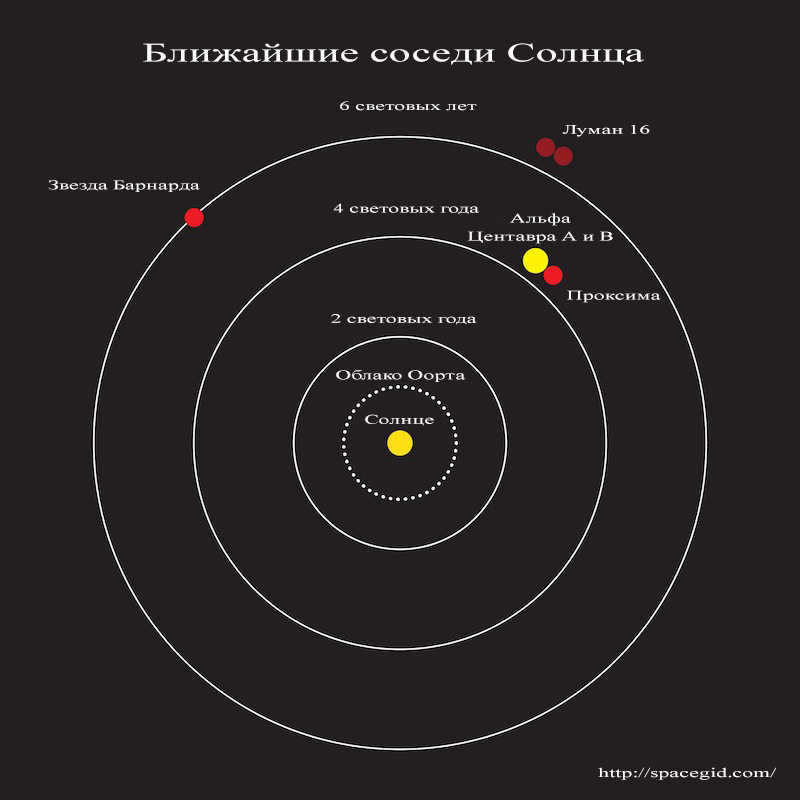
The term “light-year” is defined in astronomy textbooks as the distance traveled by a ray of light in one Earth year. While this definition may be satisfactory for amateurs, experts in cosmology consider it to be incomplete. They emphasize that a light-year is not simply the distance that light travels in a year, but rather the distance that a ray of light travels in 365.25 Earth days in a vacuum, unaffected by magnetic fields.
A light-year is equivalent to 9.46 trillion kilometers. This precise measurement of the ray path was achieved through the efforts of astronomers. Let’s delve into the details below.
The method used to measure the speed of light
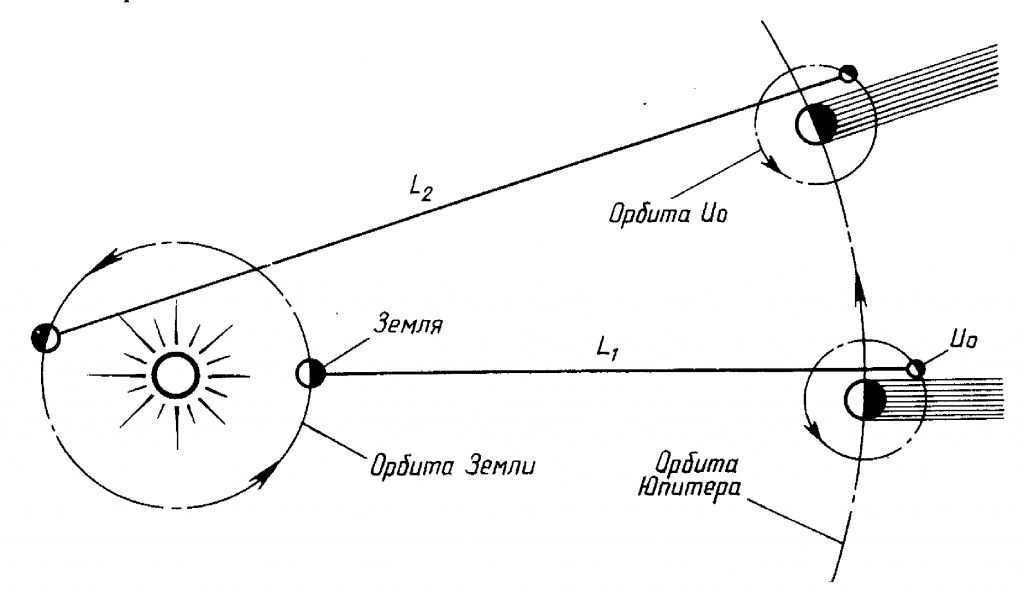
Back in ancient times, people believed that light had the ability to travel instantaneously throughout the universe. However, starting from the seventeenth century, scientists began to question this notion. Galileo was one of the first to cast doubt on this widely accepted belief. He conducted an experiment to determine the time it takes for a beam of light to travel a distance of 8 km. Unfortunately, the experiment turned out to be unsuccessful as this distance was too small to accurately measure the speed of light.
The initial breakthrough in this matter came from the famous Danish astronomer Olaf Rømer. In 1676, he made an observation regarding the variation in the timing of eclipses based on the Earth’s proximity and distance from them in outer space. Römer successfully linked this observation to the fact that as the Earth moves further away, it takes more time for light reflected from the eclipses to travel the distance to our planet.
Römer accurately grasped the essence of this fact, but he was unable to calculate a precise value for the speed of light. His calculations were flawed because in the 17th century, he did not have accurate data regarding the distances between the Earth and other planets in the solar system. This data was determined at a later time.
In 1728, James Bradley, an astronomer from England, was the first to estimate the speed of light. He discovered the phenomenon called aberration of stars and calculated the speed to be approximately 301,000 kilometers per second. However, his calculation was not entirely accurate. Later on, scientists developed more precise methods to calculate the speed of light, which did not rely on observations of celestial bodies but were conducted on Earth.
Astronomer A. Fizeau and physicist L. Foucault conducted experiments with a rotating wheel and a mirror, respectively, to measure the speed of light in a vacuum. Their experiments helped scientists get closer to the true value of this quantity.

